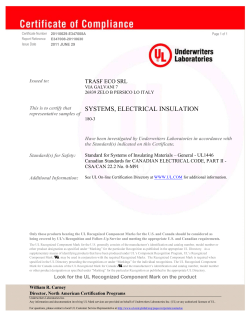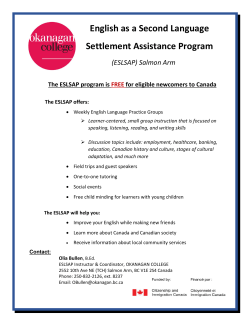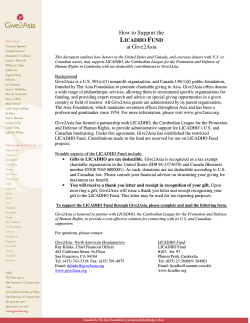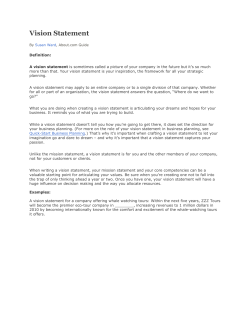
File - Northern History - Mr. Dingwall
CHC2D1/6 Course Culminating Assignment: Canadian Cultural Values Nation - A large body of people united by common descent, history, culture, or language, inhabiting a particular state or territory. Introduction It has long been argued that Canada does not meet the qualifications of a nation. At a minimum we recognize three founding heritages – the First Nations, French and British – add to the mix our country’s official policy of multiculturalism and it’s hard to identify “common descent”. An honest assessment of our history shows us that past events have divided as much as they have unified us. In the past, if you had asked anyone to identify “Canadian” culture and you would as likely to be met with a blank stare as get an informative answer and as any Torontonian knows there are dozens of languages spoken on our cities’ streets in addition to our two official languages. Even the integrity of our state has been challenged by separatism in Quebec and indigenous land claims (and, for those of you keeping track, American and Danish encroachment!). Despite these challenges Canada has emerged as what many have called the world’s first post-modern state. We have largely left behind the petty nationalism that divides people and states and emerged as a people that rally around and to, not necessarily a shared heritage or tradition but around civil and political values. Canadians have come to identify themselves by these values and in turn have sought to create just societies, here in Canada and abroad, by exporting what we have come to call Canadian cultural values. In the 21st Century there is less of a struggle to identify a Canadian culture. Many would say that our political values comprise our culture – that we have rallied to a common set of core values that we share: freedom, tolerance and democracy and it is in the sharing of these values that we, and others, see Canadians as a nation. Northern Secondary School, 2015 Page 1 of 8 CHC2D1/6 The Challenge Your challenge – the course-culminating assignment for this course – requires that you further foster the sense of a Canadian nation through the celebration of our shared cultural values. Choose a theme, drawn from Canadian history during the period 1945 - 2015, through which you can explore these values. Develop a publically commemoration of these values in a way that allows Canadians to celebrate our culture – our ‘nationhood’. Your exploration of a theme or related themes that explores the presence of freedom, tolerance and democracy should be illustrated through the creation of a series of stamps or posters or a “Heritage Minutes” video, or you can propose an alternative idea to your teacher, like a the script for a play or film, a podcast, website or speech … the ball is in your court – get creative but be certain to clear your idea with your teacher before proceeding. Important Note: While you may use the work of others (images etc.) to create your own original product, the arrangement must be entirely original and all sources must be credited. Learning Goals Through the completion of the course culminating assignment for Canadian History Since WWI it is expected that students will develop knowledge and skills in the following areas: Historical Thinking: Students should clearly employ the four Historical Thinking Concepts – Historical Significance, Cause and Consequence, Continuity and Change, and Historical Perspective – in their investigation of Canadian culture and the concept of ‘nation’ in Canadian history since 1945; Social, Economic, and Political Context: describe some key social, economic, and political events, trends, and developments between 1945 and 2015, and assess their significance for different groups in Canada; Communities, Conflict, and Cooperation: analyse some key interactions within and between different communities in Canada, and between Canada and the international community, from 1945 to 2014, and how they affected Canadian society and politics; Identity, Citizenship, and Heritage: explain how various individuals, organizations, and specific social changes between 1945 and 2014 contributed to the development of identity, citizenship, and heritage in Canada. Students will know that they have achieved these goals if they successfully examine and convey the importance of the topic(s) they have selected to the identity, citizenship and/or heritage of Canada and its people. Northern Secondary School, 2015 Page 2 of 8 CHC2D1/6 Process Part A: Topic and Media Proposal (not evaluated) Due Date: N/A The Topic Proposal is an opportunity to get feedback from you teacher to ensure that you are on the right track. You will need to complete the attached Topic Proposal sheet and provide one or two paragraphs providing a brief summary of the topic you have begun to explore, including explanation of how it might serve as a celebration of Canadian values, a short working bibliography, and a short explanation of the medium you intend to develop to explore the cultural values of Canada. Part B: Media Presentation (15%) Due Date: May 25th or 26th 2015 As is the case with any medium, when developing your product you must consider audience and purpose. In this case your audience is all Canadians and your purpose is to inform and educate Canadians about the development of Canadian cultural values – especially freedom, tolerance and democracy – sine 1945. If you do not believe that these values have emerged as consistent (yet imperfectly promoted) components of Canadian culture then you may present that perspective also. If that is your opinion, choose your medium well. For example, the Canadian government is unlikely to produce a series of stamps celebrating the failure of these values yet an independent association (like the Canadian Civil Liberties Association) might produce an informative poster assailing Canada’s failure to promote freedom. Important: Whatever medium you choose to develop it must be accompanied by an informative explanation of your goals – your exploration of and promotion of Canadian cultural values or the failure of Canada to foster those values and your attempt to push our nation towards the fulfillment of the values of freedom, tolerance and democracy for all. Your medium must be accompanied by a one page (250 word) explanation of the above and a ‘Works Consulted’ page in MLA format. Examples of Canadian stamps can be found here (be certain you limit yourself to the stamps commemorating Canadian history): http://www.canadapost.ca/cpo/mc/personal/collecting/stamps/index.jsf Examples of Canadian Promotional Posters can be found here: http://www.cic.gc.ca/english/multiculturalism/black/promotion.asp http://www.pch.gc.ca/eng/1359736104513 You can view Heritage Minutes here: https://www.historicacanada.ca/content/videos A Heritage Minute, podcast, script, screenplay or speech must be accompanied by a transcript. *Please note that the examples provided may not suit the purposes of this assignment perfectly and that you are responsible to adapt you original ideas to the expectations for the course culminating assignment and the curriculum. Northern Secondary School, 2015 Page 3 of 8 CHC2D1/6 Part C: Essay Exam (15%) Exam Date: June 10th 2015 Examining Canadian Cultural Values, 1945 – 2015 The essay question picks up where we left off after the midterm: To what degree has Canada effectively fostered at home and/or promoted abroad the values of freedom, tolerance and democracy in the period 1945 to 2015? By providing the exam question ahead of time you have the opportunity to research and draft your answer prior to writing the exam. It is highly recommended that you take advantage of this opportunity but please note that you will not be permitted to bring in your essay outline or any other kind of aid to the exam with you. Your teacher may build into the culminating period an opportunity for you to share with her or him your essay outline. If this opportunity is available to you should take advantage of it. Follow the essay writing instructions that your teacher provides to you carefully. They are marking your essay so strive to meet their expectations. If you are unclear about any aspect of the culminating assignment, including the exam, ask your teacher. Northern Secondary School, 2015 Page 4 of 8 CHC2D1/6 Example Proposal Sheet Theme(s) in Canadian History that you will examine to illustrate the presence or absence of the values of freedom, tolerance and democracy as the cornerstones of Canadian culture: __________________________________________________________________ _________________________________________________________________ _________________________________________________________________ _________________________________________________________________ Why is this theme(s) an effective example from Canadian History to illustrate the presence or absence of the values of freedom, tolerance and democracy as the cornerstones of Canadian culture: __________________________________________________________________ _________________________________________________________________ _________________________________________________________________ _________________________________________________________________ __________________________________________________________________ _________________________________________________________________ _________________________________________________________________ _________________________________________________________________ Initial Research or Working Bibliography (three sources in MLA format): Bumstead, J.M. The Peoples of Canada: A Pre-Confederation History. Oxford University Press. Don Mills, 2009. What medium will you use to convey to Canadians and the world the theme(s) you have chosen to explore and its/their importance in illustrating the presence or absence of freedom, tolerance and democracy as integral to Canada’s political culture? __________________________________________________________________ _________________________________________________________________ _________________________________________________________________ __________________________________________________________________ __________________________________________________________________ _________________________________________________________________ _________________________________________________________________ _________________________________________________________________ __________________________________________________________________ Northern Secondary School, 2015 Page 5 of 8 CHC2D1/6 Essay Outline Instructions: Plan your essay using the graphic organizer below. Write out your thesis paragraph and concluding paragraphs in their entirety. For each idea you are examining in the body of your essay write out the topic and concluding sentences and in point form record the evidence and examples your will use to support your idea (point/proof/discuss). Once you have completed your outline show a peer or your teacher for feedback and ideas that may improve your work. Thesis Paragraph Body (Supporting Ideas) Topic Sentence – Introduces the topic of your essay in general terms. Focus Sentence – Narrows the focus of your essay, bridging the gap between your topic sentence and your thesis. - topic - arguable Thesis - position - provable - area of investigation - worth proving Begin each paragraph outline with a Topic Sentence in complete sentence form. In point form include: -your main point(s); -proof (evidence, examples, etc.); -and discuss the point/proof’s relationship to your thesis. -You should have a minimum of two p/p/d relationships in each paragraph. -You are not limited to three body paragraphs and should consider more. End each paragraph outline with a Concluding Sentence in complete sentence form. Concluding Paragraph Summarize your main ideas to illustrate the successful defense of your thesis. Do not simply rewrite your thesis. Offer your audience an extension that leaves them pondering the argument you have presented in your essay. Northern Secondary School, 2015 Page 6 of 8 CHC2D1/6 Name: ________________________ Course-Culminating Assignment: Media Presentation Criteria Knowledge and Understanding Thinking The student critically links Canadian history to the emergence of the values that purportedly form Canada’s culture. •demonstrates thorough knowledge of content •demonstrates thorough understanding of content 9.8 9.5 9.2 8.8 8.5 8.2 •uses critical/ creative thinking processes with a high degree of effectiveness 9.8 9.5 9.2 8.8 8.5 8.2 Communication •expresses ideas The chosen medium effectively utilizes time, space, text/script, imagery, and colour to develop a medium clearly promoting or examining Canadian values. Where required all of the conventions of formal academic style (including MLA citations) and of the discipline are adhered to. Application The student effectively explains the connections between the medium they have developed and the Canadian cultural values they are examining. and information with a high degree of effectiveness •uses conventions, vocabulary, and terminology of the discipline with a high degree of effectiveness 9.8 9.5 9.2 8.8 8.5 8.2 •makes connections within and between various contexts with a high degree of effectiveness 9.8 9.5 9.2 8.8 8.5 8.2 Level 3 (70-79%) •demonstrates considerable knowledge of content •demonstrates considerable understanding of content 7.8 7.5 7.2 •uses critical/ creative thinking processes with considerable effectiveness 7.8 7.5 7.2 •expresses ideas and information with considerable effectiveness •uses conventions, vocabulary, and terminology of the discipline with considerable effectiveness 7.8 7.5 7.2 •makes connections within and between various contexts with considerable effectiveness 7.8 7.5 7.2 Level 2 (60-69%) •demonstrates some knowledge of content •demonstrates some understanding of content 6.8 6.5 6.2 •uses critical/ creative thinking processes with some effectiveness 6.8 6.5 6.2 •expresses ideas and information with some effectiveness •uses conventions, vocabulary, and terminology of the discipline with some effectiveness 6.8 6.5 6.2 •makes connections within and between various contexts with some effectiveness 6.8 6.5 6.2 Level 1 (50-59%) •demonstrates limited knowledge of content •demonstrates limited understanding of content 5.8 5.5 5.2 •uses critical/ creative thinking processes with limited effectiveness 5.8 5.5 5.2 •expresses ideas and information with limited effectiveness •uses conventions, vocabulary, and terminology of the discipline with limited effectiveness 5.8 5.5 5.2 •makes connections within and between various contexts with limited effectiveness 5.8 5.5 5.2 Comments: Northern Secondary School, 2015 Page 7 of 8 A student whose achievement is below Level 1 has failed to meet the expectations for this assignment. The information presented and developed in all aspects of the assignment is accurate, complete and conveys clear understanding of the topic’s place in Canadian history and its importance to Canadian values. Level 4 (80-100%) CHC2D1/6 Name: ________________________ Essay Exam: Examining Canadian Cultural, 1945 - 2015 Categories Knowledge & Understanding Level 4 80-100% Level 3 70-79% Level 2 60-69% Level 1 50-59% - the student demonstrates considerable knowledge of the period in Canadian history. - the student demonstrates some knowledge of the period in Canadian history. - the student demonstrates limited knowledge of the period in Canadian history. The degree to which the student’s work illustrates understanding of emergent Canadian cultural values in the period 1945 - 2015. -the student demonstrates thorough understanding of emergent Canadian democracy, freedom & tolerance in the period. - the student demonstrates considerable understanding of emergent Canadian democracy, freedom & tolerance in the period. - the student demonstrates some understanding of emergent Canadian democracy, freedom & tolerance in the period. - the student demonstrates limited understanding of emergent Canadian democracy, freedom & tolerance in the period. 9.6 9.2 8.8 8.5 8.2 7.8 7.5 7.2 6.8 6.5 6.2 5.8 5.5 5.2 Thinking -the student’s ideas are effectively organized and the argument is convincingly supported using the point/proof/discuss method with a high degree of effectiveness -the student’s ideas are effectively organized and the argument is convincingly supported using the point/proof/discuss method with considerable effectiveness -the student’s ideas are effectively organized and the argument is convincingly supported using the point/proof/discuss method with some effectiveness -the student’s ideas are effectively organized and the argument is convincingly supported using the point/proof/discuss method with limited effectiveness -the student selects appropriate evidence to support their argument with a high degree of effectiveness -the student selects appropriate evidence to support their argument with considerable effectiveness -the student selects appropriate evidence to support their argument with some effectiveness -the student selects the appropriate evidence to support their argument with limited effectiveness 9.6 9.2 8.8 8.5 8.2 7.8 7.5 7.2 6.8 6.5 6.2 5.8 5.5 5.2 - the student expresses her or his ideas and information with a high degree of effectiveness - the student expresses her or his ideas and information with considerable effectiveness - the student expresses her or his ideas and information with some effectiveness - the student expresses her or his ideas and information with limited effectiveness -the student uses conventions and terminology of the discipline with a high degree of effectiveness - the student uses conventions, vocabulary, and terminology of the discipline with considerable effectiveness - the student uses conventions, vocabulary, and terminology of the discipline with some effectiveness - the student uses conventions, vocabulary, and terminology of the discipline with limited effectiveness The student’s ideas are organized and the argument is convincingly supported using the point/proof/discuss method. Appropriate evidence is selected to support the student’s argument. Communication The student writes effectively for her or his purpose (e.g. writing is persuasive and powerful, clear and coherent, transitions are effective, ideas are clear and concise, vocabulary is appropriate …). All of the conventions of formal academic style and the language of the discipline are adhered to. 9.6 9.2 8.8 8.5 8.2 7.8 7.5 7.2 6.8 6.5 6.2 5.8 5.5 5.2 - The student applies knowledge and skills developed in class with a high degree of effectiveness - The student applies knowledge and skills developed in class with considerable effectiveness - The student applies knowledge and skills developed in class with some effectiveness - The student applies knowledge and skills developed in class with limited effectiveness 9.6 9.2 8.8 8.5 8.2 7.8 7.5 7.2 6.8 6.5 6.2 5.8 5.5 5.2 Application The student’s thesis paragraph effectively introduces the topic and develops a position, the thesis contains all of the required elements, and the conclusion effectively illustrates a successful argument. A student whose achievement is below Level 1 has failed to meet the expectations for this assignment. -the student demonstrates thorough knowledge of the period in Canadian history. The degree to which the student’s work illustrates knowledge of the period in Canadian history. Comments: Northern Secondary School, 2015 Page 8 of 8
© Copyright 2025









